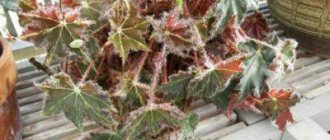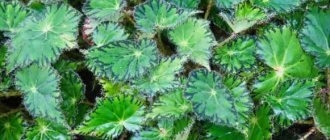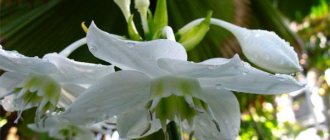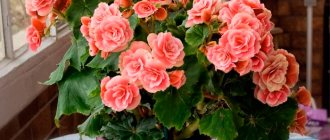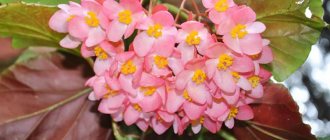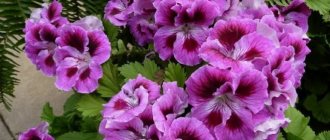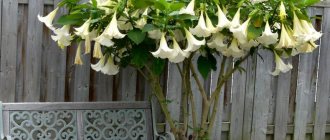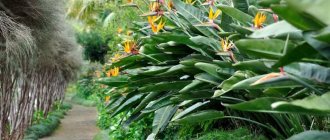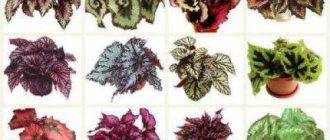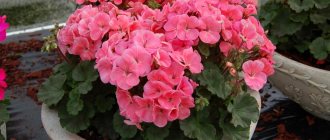An incredibly spectacular indoor plant, the royal begonia is often also called the Rex begonia. This ornamental plant is quite popular in indoor culture due to its large leaf plates that have an unusual color and shape. The flower also has the ability to make the air in the room cleaner.
Often you can understand that this flower is truly incredibly beautiful only by seeing it with your own eyes. The fact is that even the highest quality photographs cannot convey all the beauty of the royal begonia.
Botanical description
Royal Begonia is directly related to the Begoniaceae family. Another name for this variety is Rex. Among the people, royal begonia received the nickname “frostbitten ear” or “Napoleon’s ear” , this was in 1812 during the flight of French troops from Moscow. Indeed, the outline of the leaf on the lower red side resembles a frostbitten ear.
In nature, this plant can be found in northeast India. Height varies from 15 to 40 cm.
The flower is distinguished by asymmetrical leaves, which have a beautiful pattern and unusual color. The color scheme is represented by green-brown shades with hints of silver. The shape of the leaf is also different and can be heart-shaped, round, oval, snail-shaped. The edges of the leaves can be carved or wavy and only occasionally whole.
The stem of the plant is quite large, fleshy , the root system is branched and sometimes protrudes to the surface.
Despite all the beauty of the leaves, the flowering of the royal begonia is rather sparse and for best growth the inflorescences are often removed.
Features of Rex begonia
Royal begonia is a member of the Begoniaceae family, which includes more than 1,600 species. Moreover, such a large family received its name in honor of Michel Begon, who was a Frenchman.
The plant has spectacular asymmetrical leaf plates with a carved edge. They can be painted in a variety of shades and their combinations (depending on the variety). Begonia has a fleshy, voluminous rhizome that rises slightly above the surface of the substrate.
During the flowering period, small unsightly flowers appear on the bush. Since they have a nondescript appearance, they do not represent any decorative value. Therefore, Rex begonia is grown as an ornamental foliage plant.
Begonia Royal Rex and its varieties. My new acquisitions.
Photo
Below are photos of royal begonia grown at home:
Photo of royal begonia flowering:
Kinds
There are many varieties of Rex begonia. All these subspecies can be divided into:
- leafy;
- tuberous;
- bush.
The first is ideal for keeping indoors. Tuberous feels great outdoors. The bush blooms the longest.
Spare no time and effort and get a Rex begonia in your apartment. You will be pleasantly surprised by the unusual shape and bright colors of the plant’s leaves. If you take proper care of the royal flower, it will invariably delight you with its splendor and beauty.
Care
Despite its ease of care, the royal begonia will need to create a number of conditions under which it will grow healthy and delight the owner with its beauty.
Location and lighting
Royal begonia needs a lot of light, but direct sunlight can be destructive for it - burns will appear on the leaves and the flower will die. The ideal place for it would be opposite the window : a shelf, table or cabinet.
Be sure to use tulle to diffuse the light. The sun's rays negatively affect not only the health of the flower, but also its appearance. From too much sun, the leaves become faded and dry at the edges.
Watering frequency
Watering is required abundantly. When the top layer of soil dries out, the flower should be watered immediately. In winter, the amount of watering should be reduced, following the same rule regarding drying out the soil.
The main rule of watering is to provide the indoor plant with the amount of water it needs, while not allowing the liquid to stagnate in the root system. To do this, you can put moistened expanded clay, pebbles or sphagnum moss in the tray of the pot.
Air humidity
Due to its origin, royal begonia loves moist air, so you should stick to 50-60% .
There are several possible ways to humidify the air:
- Spray the air around the flower, avoiding droplets getting on the leaves.
- Place wet pebbles or expanded clay on a tray. You can also use sphagnum moss or a cloth soaked in water.
- Buy a humidifier and set it to the required level to maintain moisture.
It is necessary to maintain high humidity only in summer ; in winter, this is not necessary.
A couple of times a month, the leaves of the plant should be wiped from accumulated dust using a soft sponge or cloth.
Temperature Requirements
A thermometer reading of 18-24 degrees will be optimal for royal begonia. If the temperature rises above 26 degrees, the flower may die.
In winter, it is better to place the flower on an insulated balcony, where the air temperature should not fall below +16 degrees.
Remember, royal begonia does not like drafts, so in winter you should not place the pot close to the window.
Fertilizer
You need to feed the plant no more than once a month .
You can purchase complex mineral fertilizers. Before using them, the flower must be thoroughly moistened. Organic fertilizers also work well for royal begonias. To prepare them you will need horse or cow dung diluted with water in a ratio of 1:5.
Transfer
You need to replant a houseplant at least once a year in the spring. In order not to harm the plant, when replanting you need to follow a number of rules:
- The new pot should be wider than the bush by only 2-3 cm in diameter. In this case, the depth should remain the same.
- When replanting a flower, the roots should be handled very carefully. When removing the plant, the soil must be moistened and the earthen ball carefully turned over. If this cannot be done, then the old pot will have to be carefully broken.
- The soil must be prepared in advance, and the container for replanting should be wide, not deep. This is due to the rapid expansion of the root system.
- Several varieties of this family can be placed in one large flowerpot. The result will delight the owner with an original flower arrangement.
Flower rejuvenation is carried out once every 3 years.
Soil composition
The soil should be laid as follows:
- A drainage layer consisting of pebbles or expanded clay is laid at the bottom;
- The drainage is sprinkled with a layer of sand or charcoal;
- A soil mixture of peat, leaf and turf soil is laid;
- The soil surface is thoroughly moistened and the flower can be planted.
When laying layers, you need to remember that the drainage layer should not occupy more than a third of the pot , and lay the substrate not to the very edges, but with an indentation of a couple of centimeters. When planting, the upper part of the root must remain on the surface, otherwise it may rot.
Trimming
During flowering, it is recommended to trim the inflorescences, because their appearance significantly affects the appearance of the plant - it becomes depleted, and the leaves lose their attractiveness.
At the end of the winter period, with the arrival of spring, active growth occurs. By this time, you should prepare and pinch the rhizome, and move its young parts to the center of the pot. If everything is done correctly, the royal begonia will delight you with the splendor of its leaves and the formation of young shoots.
Reproduction methods
There are several propagation methods for royal begonia:
- Cuttings;
- Using a sheet;
- Seeds;
- Dividing the root.
Each of them has its own nuances, which we will discuss further.
Cuttings
Reproduction by cuttings is possible only from adult plants (from 3 years old) . The procedure is as follows:
- For propagation, choose strong, healthy cuttings 10 cm long. They must be cut with a knife, the lower leaves removed, and the upper ones cut in half.
- Dry the cuttings for 2 hours and treat the cut with Kornevin or Heteroauxin.
- Prepare a substrate consisting of special soil for begonias and river sand.
- Plant the cuttings in a container to a depth of 2 cm, cover with glass or polyethylene.
- Regularly moisten the soil with a sprayer and periodically ventilate the container.
- When the first shoots appear (after 4-5 weeks), remove the protective film.
Leaf
Leaf propagation is suitable for both young and adult royal begonias. The technology is as follows:
- To obtain new plants, select a large, healthy-looking leaf and cut it into several parts so that each of them has a central vein.
- Prepare the soil for planting: mix wet sand and peat in equal proportions.
- Place the pieces of leaf on the surface of the soil at a distance of several centimeters from each other.
- We press the leaves a little deeper into the soil (no deeper than 1 cm) or sprinkle them with a little soil.
- Cover the container with transparent film or glass and place it on the windowsill.
As the soil dries, you will need to moisten it with a sprayer so that it is moderately moist. After the first shoots appear (after 6-8 weeks), the container with plants can be opened slightly.
Seeds
The seed propagation method is considered the most difficult of all, because
requires much more time and attention. For planting, you can choose regular (untreated) or granulated seeds. The latter are much easier to work with, so experienced gardeners often choose them.
Instructions for proper landing are as follows:
- As a general rule, seeds should be planted in early spring. Before planting, they should be soaked in a 1% manganese solution for 30-45 minutes.
- Wash the seeds and plant them in a peat tablet, which must be moistened in advance.
- Each tablet is placed on a tray and covered with cling film or glass on top. To keep the tablet always moist, water is constantly added to the tray.
- After the formation of the first shoots (usually after 2-3 weeks) and the appearance of the 3rd leaf, a dive is performed. The procedure must be repeated 8 weeks after emergence.
- Young plants are planted in separate pots.
To grow royal begonia from seeds, the optimal room temperature should be at least 20-22 degrees.
Dividing the bush
The method is most optimal for adult representatives of this variety who are more than 3 years old. The procedure should be carried out in the spring . The procedure is as follows:
- The flower must be carefully removed from the pot, and then the entire root system must be thoroughly rinsed with cool running water.
- Divide the rhizomes with a sharp knife so that 1-2 buds remain on each part.
- Sprinkle the cuts with charcoal.
- Place the flowers in separate pots and water generously.
To speed up the process, you can use Kornevin or Heteroauxin.
How to make it bloom?
Experienced gardeners manage to achieve flowering within 6-12 months. To do this, you must adhere to a number of rules:
- Trim all female flowers of young begonias;
- Fertilize the plant 3 times a month;
- Do not apply fertilizers containing nitrogen;
- Trim spent flowers to prolong flowering.
Not all varieties have a pleasant aroma; some do not have it at all. For example, the Bauman variety has a pleasant aroma and has medicinal properties - it helps cleanse the bronchi and helps with problems with the respiratory tract.
At the end of flowering, the plant needs rest. In place of the flowers, small boxes with seeds are formed . The frequency and duration of flowering of the royal begonia depend on the correct care of it and whether pollination occurs.
What benefits does the plant bring?
There is no need to talk for long about the aesthetic benefits of royal begonia - just look at the photo of this beautiful flower. However, along with its undeniable decorative value, the plant also benefits the health of all households:
- cleans the air of dust that accumulates on the surface of large leaves;
- inhibits bacteria moving in the atmosphere of the house;
- juice in leaf cells promotes wound healing;
- the beneficial effect on the air makes breathing easier, which is especially useful for people who abuse smoking.
It is believed that royal begonia harmonizes the energy of space, uplifts the mood and relieves stress. In this regard, it is perfect as a gift for a home where people often quarrel or become depressed.
This ends the story about the royal begonia. Despite the fact that the article provides quite a lot of recommendations for caring for this indoor plant, in fact it is not so whimsical. In addition, your efforts will definitely be rewarded - if the described conditions for caring for begonia are met, this beautiful flower will royally thank its owner. It will charge the home atmosphere with favorable waves and become a real center of attraction for everyone's attention.
Diseases and pests
For royal begonia, as for many indoor flowers, harmful insects pose a particular danger.
As a rule, they attack a weakened plant, which is why it is so important to follow all the rules for caring for it. Major pests include spider mites, scale insects and thrips. There are several methods to combat them:
- If detected in a timely manner, the insects are removed mechanically, and the flower is temporarily quarantined, away from healthy plants. Treat with soapy water.
- If the first method does not work or there are too many insects, then spraying with insecticides will be necessary. You can use Actellik, Fitoverm or Nurell-D.
Prepare your own pest repellent:
- Take onions with brown skins, finely chop or chop them;
- Dilute 1 teaspoon in a liter of water and leave for a week;
- Strain and spray the flower with the prepared solution.
In addition to pest damage, it is important to pay attention to the rules of care, because at the slightest violation the flower can get sick. The most dangerous of them are:
- Powdery mildew, which appears due to sudden changes in temperature and excess air moisture. It is not difficult to detect - a characteristic white coating will appear on the plant.
- Root rot. The main reason for its appearance is too frequent watering and stagnation of water in the roots. Therefore, it is very important to create a drainage layer at the bottom of the pot and not to overdo it with watering.
To help the plant you will need to remove the affected areas and treat it with a fungicide solution: Topaz, Skor or Fitosporin. In some cases, replanting into fresh soil will be required.
Possible problems
Despite its resistance to a variety of negative environmental factors, begonia is characterized by a fairly high susceptibility to a variety of diseases and pests. Although they are often not capable of causing plant death, when intensively developed they cause almost complete aesthetic unsuitability of plants.
Often this can serve as a thorough sentence for the destruction of even the rarest and most exquisite specimen.
Diseases
Most often, royal begonia is affected by the following ailments:
- Powdery mildew is a complex infectious disease caused by parasitic fungi Erysiphales
. The source of the disease is water, litter, garden tools, etc., contaminated with fungal hyphae. The infection appears in the form of a white coating on the leaves and stem. It causes tissue destruction and inhibition of flower growth. They fight the disease using complex fungicides for indoor plants (Topaz, etc.). They are used in two courses, 14 days apart. The concentration of the medicinal solution is selected based on the manufacturer’s recommendations; - gray rot is a fungal infection caused by the development of the fungus Botrytis cinerea on the outer covers of begonias.
The source of the disease is soil contaminated with sclerotia or conidia of the pathogen or its remains. The disease manifests itself in the form of numerous gray, black or brown rotten spots on the stem or leaves. They fight the disease by spraying begonias with a 0.2% solution of Fundazol or a 1% solution of Bordeaux mixture; - ring spot is a viral infection of plants caused by the Tomato black ring virus.
The pathogen is transmitted by small nematodes belonging to the genus
Longidorus
. Most often, the disease manifests itself in the form of dark or light green spots on the foliage, smoothly turning into necrotic areas. Today, the disease cannot be treated, so to prevent its spread, affected plants are burned.
Pests
Among the pests actively developing on begonias are:
- soft scale insect - causes inhibition of flower growth, as well as deformation of the leaf blade. The pest can be identified due to the characteristic sugary secretions and the appearance of sooty fungi on the leaves and stem. To eliminate the pest, every 14 days (until traces of the parasite disappear), the plant is treated with a solution based on pyrethrum or garlic infusion (10 g/l of water);
- The greenhouse whitefly is a small white insect, several millimeters in diameter. Parasitism causes inhibition of begonia growth, as well as wilting of foliage and stems. They fight the pest by treating the flower with a soap solution (4 g of laundry soap per 1 liter of water);
- The root-knot nematode is a microscopic worm that parasitizes the root zone. The parasite causes growths to appear on the stem, which lead to the wilting of the begonia. They fight it by removing the affected areas of the plant, followed by treatment with a 0.05–0.2% Heterophos solution;
- aphids are small black insects that parasitize the underside of leaves and stems. Aphids cause wilting and drying out of individual parts of the flower. It is eliminated by treating the plants for 5–7 days with an infusion of onions (15 g/l of water);
- Spider mite is a small insect that causes wilting of the stem and leaves. The mite manifests itself as a characteristic web, which entwines the affected areas of the begonia. In order to overcome it, plants are treated with onion infusion (15 g/l of water) for 5–7 days.
Royal begonia is a rather exotic, but at the same time unpretentious plant, so it can be safely grown in almost any climate, both in open soil and in indoor flowerpots.
Despite this, the plant requires a special microclimate from a person, including protection from pests, as well as common diseases. Otherwise, the exquisite begonia turns into an average garden weed.
Photo gallery
tsvetochnyy_blyuz
tsvetochnyy_blyuz
marinavlmk__
irina_fialki74
olivka.de
olgamakarovaizorla
amaryllis_blog
bilyknata7
